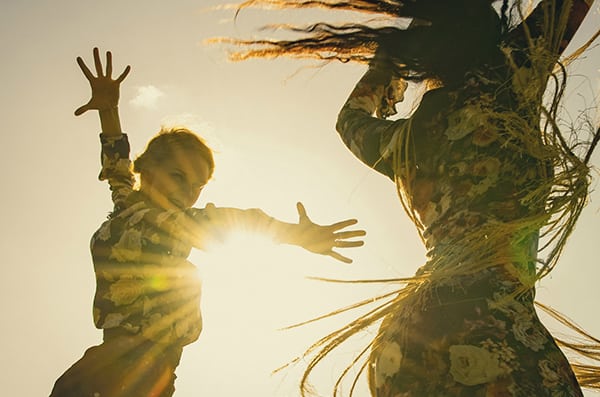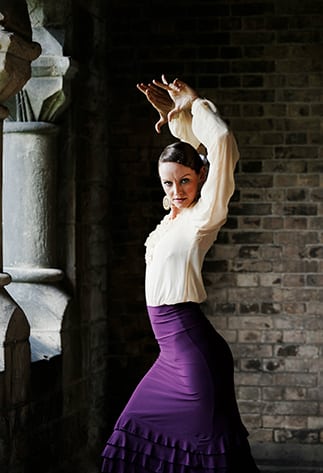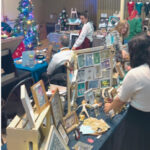Home »

Dancer followed passion to Spain and back
Fin de Fiesta Flamenco ‘Salvaje’ coming to The Stage Door July 24
By Lia Grainger

In the fall of 2012, I moved to Seville, Spain, to become a full-time student of flamenco dance. I left Toronto behind, and along with it a rewarding career as a freelance journalist and a cozy home. I had no idea when I would be back, but I was compelled to go.
If you’ve only seen flamenco in Mission Impossible movies or ads for Spanish holidays, the word probably conjures visions of exotic women in long, red, ruffled dresses clicking castanets, their feet pounding the ground to the rhythms of guitar.
This is the easily digestible veneer. Most people viewing the real thing are struck less by flamenco’s beauty than by the raw, uninhibited emotion of the cante (song) and baile (dance).
I saw flamenco for the first time in a restaurant on Cambie Street in Vancouver 15 years ago. I was 21 and, at six-foot-two, had recently quit a promising varsity basketball career in search of a more creative path. I was casting about for something new to attack, and I found it that night.
The dancer was a woman named Kasandra, and she performed with every inch of her body, commanding the musicians with the subtlest flick of her wrist.
She breathed intensity.
I wanted it.
I started classes, and was an instant addict. My build, however, presented some challenges, for Spanish women are not typically six-foot-two rakes. Turns and balance proved precarious with such a high centre of gravity, and it was often near impossible to imitate the lines and movements of teachers close to a foot shorter than me.
Fortunately, one of the most beautiful things about flamenco is that it doesn’t discriminate. Unlike ballet and other dance forms that demand youth and beauty, flamenco welcomes the young, old, small, tall, skinny and fat; in fact, many moves are actually most impressively executed by sassy, large older women.
One class a week became four and, within a couple of years, I was dancing at Kino Cafe. I began traveling to Spain to take classes in Granada, Sevilla, Madrid. Soon, I was living there.
 I’d awaken to the sound of my French flamenco guitarist roommate strumming falsettas on the terrace outside my bedroom window. Then I’d stroll two blocks down cobbled sun-soaked streets to the Andrés Marín Flamenco Academy, where, in a small windowless studio, flamenco legend Ursula Lopez would bark orders at a classroom full of flamenco dancing foreigners like myself.
I’d awaken to the sound of my French flamenco guitarist roommate strumming falsettas on the terrace outside my bedroom window. Then I’d stroll two blocks down cobbled sun-soaked streets to the Andrés Marín Flamenco Academy, where, in a small windowless studio, flamenco legend Ursula Lopez would bark orders at a classroom full of flamenco dancing foreigners like myself.
We’d sweat, cry and even faint, but then we’d get better.
At night, I’d seek out hole-in-the-wall tablaos and watch weathered men wail mournful letras (verses) as the country’s up-and-coming bailaoras, danced for audiences made up of myself and a few dozen others.
Often, it was lonely. It didn’t help that flamenco is often a solo pursuit. For €3 an hour, I rented a tiny studio and ran drills and choreographies alone for two hours a day. I danced four to five hours a day, five days a week. Classes were gruelling, teachers could be mean, and the language barrier made my classmates seem unapproachable.
Eventually, I relaxed. As my Spanish improved, I made friends with dancers and musicians from around the world. I found an expat community of artists in Seville who had all made the same decision as I did, and who shared my doubts, struggles and determination.
“We all left everything we had to go there, to this other place. We didn’t know what was waiting for us — we just felt drawn,” explains Dennis Duffin, a Canadian flamenco guitarist.
Duffin is a member of Fin de Fiesta, a group of Canadian, French and Cuban flamenco artists I assembled in Spain, and who are currently touring Canada. Duffin had just completed his PhD in astrophysics when he put his academic career on hold to spend a year in Seville. That was six years ago.
“I didn’t have a job and I didn’t have the money, but I decided I was going to be there no matter what,” he said.
It’s a certain type of person who takes that leap of faith. It takes bravery, foolishness and a lot of desire — common shared traits among the international flamenco students who have made the pilgrimage to Spain.
Those of us touring with Fin de Fiesta recently returned from Spain share what we’ve absorbed with Canadian audiences. But we’ll be back before long.
There, we learned that flamenco is a malleable art form open to endless interpretation. We also learned that, in many ways, it is still bound to a specific geographical context. Before we could make it our own, we needed to experience flamenco in the place of its genesis.
Fin de Fiesta will perform their new production, SALVAJE, on July 24, 7:30 p.m., at The Stage Door, 11 11th Avenue S., in Cranbrook.
Tickets: $25 $22 advance, In person at Just Music or online at www.findefiestaflamenco.com
 The troupe is also performing at Nelson’s Shambhala Music Hall on July 19 and Golden’s Civic Centre on July 26.
The troupe is also performing at Nelson’s Shambhala Music Hall on July 19 and Golden’s Civic Centre on July 26.
Photos submitted







